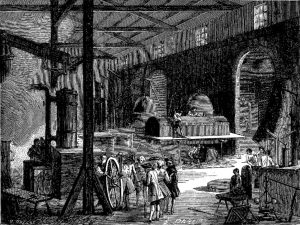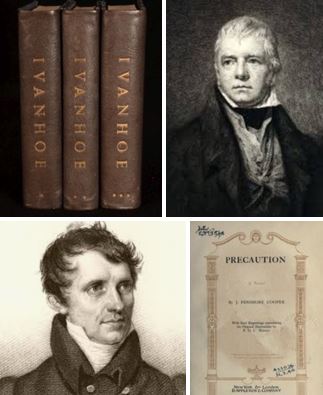 Miniature figures or miniature soldiers in general have been around as talismans or devotional objects for many centuries. However, the ‘modern’ toy soldier – a product explicitly marketed to children to play with – was created in the 18th century in Prussia. The first tin toys were flat, two-dimensional figures. They started as a by-product of the tin-ware production.
Miniature figures or miniature soldiers in general have been around as talismans or devotional objects for many centuries. However, the ‘modern’ toy soldier – a product explicitly marketed to children to play with – was created in the 18th century in Prussia. The first tin toys were flat, two-dimensional figures. They started as a by-product of the tin-ware production.
The Reichenbach Case – Industrial Espionage at Boulton & Watt
 In the late 18th century, Bavaria was an economically backward state, heavily relying on agriculture. Bavaria’s Elector, Karl Theodor (1777-1799), though usually more interested in arts and philosophy than in state affairs, was aware of the problems arising from a weak industrial economy – especially with the French revolutionary army roaming Europe. Karl Theodor looked to England, a prosperous nation, and the number 1 in technical innovation.
In the late 18th century, Bavaria was an economically backward state, heavily relying on agriculture. Bavaria’s Elector, Karl Theodor (1777-1799), though usually more interested in arts and philosophy than in state affairs, was aware of the problems arising from a weak industrial economy – especially with the French revolutionary army roaming Europe. Karl Theodor looked to England, a prosperous nation, and the number 1 in technical innovation.
Plotting
Karl Theodor – probably inspired by his consultant, the smart Count Rumford – came up with a cunning plan: Continue reading
The Unconventional Miss Starke: Writer and Adventuress
 One of the most proficient travel writers of the late 18th century was – a woman: Mariana Starke. Her travel guides were an essential companion for British travellers to the Continent.
One of the most proficient travel writers of the late 18th century was – a woman: Mariana Starke. Her travel guides were an essential companion for British travellers to the Continent.
Being successful didn’t make life easy for Mariana. Female writing for the public was frowned upon. From her years as budding authoress to the latest edition of her successful travel guide, she always had to deal with criticism from more conventional members of society. Unperturbed by this, she led an unusual life for a woman of her time. Continue reading
The year Napoleon shot the goat that ate his plants and other events of 1820
 A secret submarine plot, death in the Royal family, and the Queen’s trial are events of a year marked by political unrest and economic depression.
A secret submarine plot, death in the Royal family, and the Queen’s trial are events of a year marked by political unrest and economic depression.
After the Napoleonic Wars the economy was still down, and important reforms had been delayed over the wars. The fear of Napoleon’s influence was still tangible, with rumours about his possible escape from St. Helena becoming stronger by the end of the year. Additionally, the monarchy was in a crisis, shaken by death and scandal.
Which political, scientific, social, and literary events and anniversaries are of interest to Regency Enthusiasts in 2020? Have a look at my list of 20 events of 1820 here: Continue reading
What are the best reads in 1820?
 If you were a time traveller in 1820 longing for a good read, what would be your options?
If you were a time traveller in 1820 longing for a good read, what would be your options?
Check out the list of popular fiction releases, and the latest findings from science, travel, and philosophy on the non-fiction book shelf!
I have added links to online versions of each book, so you can actually read like its 1820:
Continue reading
A Gala Dress-Suit Made for a Liberal Aristocrat

This beautiful gala dress-suit was made in the seconded half of the 18th century. Enjoy some pictures of a truly splendid garment and read more about its owner: an Italian aristocrat with liberal ideas and close links to Napoleon.
Continue readingSmuggling Moonshine

Brandy, tea, salt – these products are famed-famous as objects of smuggling in the 18th century. Did you know that Scottish whisky was an object of the illegal trade, especially between 1780 – 1823? Whisky was called ‘moonshine’ then, as it was illicitly produced at night in small cottages in the Highlands, and secretly transported by smugglers to harbours for further distribution.
Continue readingDon’t Expect Napkins at an Inn – A Continental Explorer’s View on Georgian England

Georg Forster was a central figure of the Enlightenment in Germany. He travelled with Captain James Cook on the second voyage (1772-1775), and was a member of the Royal Society. He also became known as the founder of modern travel writing.
In 1790, the famous scientist chose England as his destination. Young Alexander von Humboldt accompanied him, at that time a budding scientific talent.
Forster turned the impression of the trip into a book titled “Views of the Lower Rhine, from Brabant, Flanders, Holland, England, and France in April, May and June 1790”. It was published from 1791–94.
Here are some observations on Georgian England meant to amuse readers on the Continent:
Continue readingAnna on stage at “StadtLesen” in Ottobrunn
I have been honoured to join the performing authors at a public reading event from October 24 – 27, 2019. My historical novel “Von tadellosem Ruf” (”Of impeccable reputation”) took the audience back in time to the England of Jane Austen. I read together with big names of the German book scene, as Dorothée Kreusch-Jacob, a noted author and song writer for children, Quint Buchholz, a leading illustrator, and novelist and journalist Ruth Eder.

Continue reading
Becoming Alexander von Humboldt – A Budding Explorer in Georgian England

and in 1806 (right).
Alexander von Humboldt (1769 – 1859) was the celebrated explorer of his generation. It is little known that he started his scientific career with a trip to England in 1790. He was 20 years old, and travelled with the famous Georg Forster, author of “A Voyage Round the World”, member of the Royal Society and of Captain James Cook’s crew on the second voyage (1772-1775).
The experienced explorer and the young men had met in 1789 in Mainz / Germany. Alexander was fascinated by the lively and powerful Forster, his impressive career and exiting plans. He dedicated his first scientific thesis about mineralogical observations on basalts to Forster.
It is no surprise that Alexander was delighted when Forster, recognizing the budding talent, asked the young man to join him on his next trip in 1790. Destination: England.
Find out how the journey to England influenced the life of Alexander von Humboldt.
